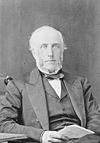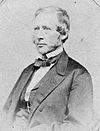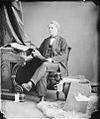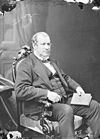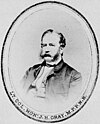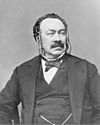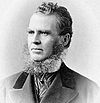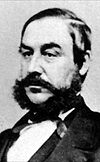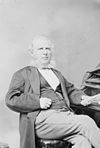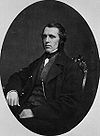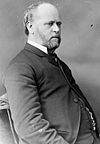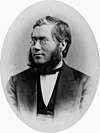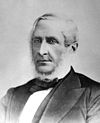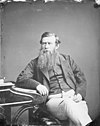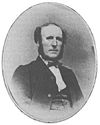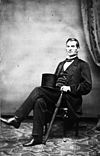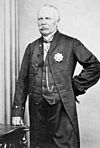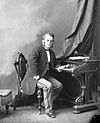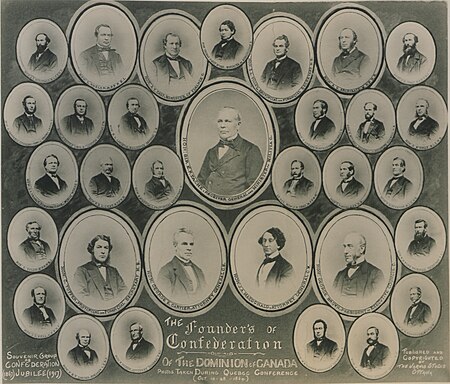Fathers of Confederation
| This article is part of a series on |
| Canadian Confederation |
|---|
 |
| Conferences |
| People |
| Related |
|
|

The Fathers of Confederation are the 36 people who attended at least one of the Charlottetown (23 attendees) and Quebec (33) Conferences in 1864 and the London Conference of 1866 (16) in England, preceding Canadian Confederation. The following lists the participants in the Charlottetown, Quebec, and London Conferences and their attendance at each stage.[1][2]
Queen Victoria has been called the "Mother of Confederation".[3] Her role in Confederation is recognized by the celebration of Victoria Day in Canada.
Four other individuals have been labelled as Fathers of Confederation. Hewitt Bernard, who was the recording secretary at the Charlottetown Conference, is considered by some to be a Father of Confederation.[4] The leaders most responsible for bringing three specific provinces into Confederation after 1867 are also referred to as Fathers of Confederation.[1] The provisional government established by Louis Riel ultimately negotiated the terms under which Manitoba entered the Canadian Confederation in 1870.[5] The leadership of Amor De Cosmos was instrumental both in bringing democracy to British Columbia and in bringing the province into Confederation in 1871.[6] The province of Newfoundland entered the Canadian Confederation in 1949 under the leadership of Joey Smallwood, who was then referred to as the "only living Father of Confederation".[7]
Of the 36 Fathers, 11 were Freemasons, notably Macdonald, but including Bernard, Campbell, Carter, Chandler, Galt, Gray, Haviland, Henry, Pope, and Tilley.[8]
Table of participation
Historic photographs
-
Delegates from the Legislatures of Canada, gathering on the steps of Prince Edward Island's Government House for the Charlottetown Conference – Photo by George P. Roberts on September 11, 1864.
-
Delegates of the Legislatures of Canada gathering at the Quebec Conference – Photo by Jules I. Livernois on October 27, 1864.
See also
- List of Prime Ministers of Canada
- List of national founders
- Persons of National Historic Significance
- Anti-Confederation Party
References
- ^ a b "Fathers of Confederation". CanadianHistory. 2008. Archived from the original on 2010-08-21. Retrieved 2010-06-21.
- ^ a b Bélanger, Claude (2001). "Studies on the Canadian Constitution and Canadian Federalism". Department of History, Marianopolis College. Archived from the original on 2010-06-11. Retrieved 2010-06-21.
- ^ Bouard, Arthur; Toffoli, Garry (1991). Royal Observations. Toronto: Dundurn Press Ltd. p. 10. ISBN 1-55002-076-5. Archived from the original on July 21, 2011. Retrieved September 14, 2010.
The Queen's role in promoting Canadian unity truly made her the "Mother of Confederation" and at her death Victoria Day, that uniquely Canadian holiday, was created as a memorial day...
- ^ Harrison, Robert A (2003). The conventional man. Canadian Legal History by University of Toronto Press. p. 627. ISBN 0-8020-8842-2. Archived from the original on 2018-03-28. Retrieved 2011-09-02.
- ^ The Heritage Centre. "Louis Riel The Provisional Government". Archived from the original on 10 August 2007. Retrieved 23 September 2007.
- ^ Frances, Stanford (2002). Canada's Confederation. S&S Learning Materials. p. 44. ISBN 1-55035-708-5. Archived from the original on 2018-03-28. Retrieved 2011-09-02.
- ^ Argyle, Ray (2012). Joey Smallwood, Schemer and Dreamer. Dundurn Press. ISBN 9781459703698.
- ^ Michael Jenkyns (July 2017). "Canada's Sesquicentennial - Freemasonry and Confederation". Grand Lodge A.F. & A.M. of Canada in the Province of Ontario. Archived from the original on 5 December 2018. Retrieved 5 December 2018.
Further reading
- Careless, J.M.C. "George Brown and Confederation," Manitoba Historical Society Transactions, Series 3, Number 26, 1969-70 online
- Coucill, Irma (2005). Canada's Prime Ministers, Governors General and Fathers of Confederation. Pembroke Publishers. ISBN 1-55138-185-0.
External links
- Fathers of Confederation - Library and Archives Canada


